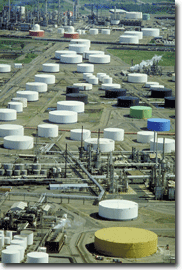"OPC gives us the flexibility to expand; it enables us to add data from any other OPC-compliant system",
Control Engineer, European Oil Company
 Plan to Improve
Plan to Improve
A major European oil company upgraded their refinery as part of a strategy to enhance plant profitability, increase throughput capacity, upgrade product yields and improve on-stream reliability. One of the upgrades performed at the refinery was the integration of an Automated Tank Gauging system (ATG). Traditionally, the operation collected data manually from their farm of tanks. Twice a day a group of people were deployed to visit every tank, climb to the top, measure tank levels using a stick, record the information and then enter it into the refinery’s Tank Information System (TIS). The logistics of climbing on the tanks and exposure to potentially inclement weather posed considerable safety concerns. As well, the data collected was not accurate as temperature can significantly impact the volume of a tank. Consider, for example, that a change in temperature requires corrected level values which account for the thermal expansion of the tank walls. A manual reading out by 1 mm and multiplied by 74 tanks can cause a significant discrepancy between actual and recorded inventory levels. Also consider the impact of a tank that leaks. This causes serious repercussions not just for the industry, but for the environment as well. In addition, the time consuming manual gauging process meant data was not available in real-time to plant operators and key decision makers. Finally, manual data entry errors would sometimes mean that inventory was incorrectly calculated.
The Automated Tank Gauging system enabled terminal operators to have easy real-time access to all measured
and calculated parameters, such as level, temperature